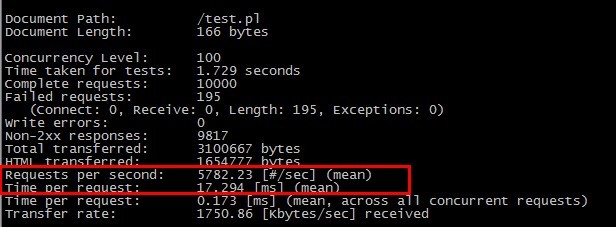本篇内容介绍了“Linux下如何用Nginx作Perl程序服务器及其中Perl模块”的有关知识,在实际案例的操作过程中,不少人都会遇到这样的困境,接下来就让小编带领大家学习一下如何处理这些情况吧!希望大家仔细阅读,能够学有所成!
perl + fastcgi + nginx搭建
nginx + fastcgi是php下最流行的一套环境了,那perl会不会也有fastcgi呢,当然有,今天来搭建下nginx下perl的fastcgi.性能方面也不亚于php,但是现在web程序php的流行程度perl无法比拟了,性能再好也枉然,但是部分小功能可以考虑使用perl的fastcgi来搞定.进入正题.
1. 准备软件环境:
nginx
perl:系统自带
fastcgi
1.2 perl安装
一般linux都有自带perl,可以不用安装,如果确实没有,请执行:
# yum install perl
1.3 perl-fastcgi安装
# cd /usr/local/src # wget http://www.cpan.org/modules/by-module/fcgi/fcgi-0.74.tar.gz # tar -xzvf fcgi-0.74.tar.gz # cd fcgi-0.74 # perl makefile.pl # make # make install
2. nginx虚拟主机配置
server {
listen 80;
server_name test.jb51.net;
#access_log /data/logs/nginx/test.jb51.net.access.log main;
index index.html index.php index.html;
root /data/site/test.jb51.net;
location /
{
}
location ~ \.pl$
{
include fastcgi_params;
fastcgi_pass 127.0.0.1:8999;
#fastcgi_pass unix:/var/run/jb51.net.perl.sock;
fastcgi_index index.pl;
}
}如果想把tcp/ip方式改为socket方式,可以修改fastcgi-wrapper.pl.
$socket = fcgi::opensocket( "127.0.0.1:8999", 10 ); #use ip sockets
改为
$socket = fcgi::opensocket( "/var/run/jb51.net.perl.sock", 10 ); #use ip sockets
3. 配置脚本
3.1 fastcgi监听脚本
文件路径:/usr/bin/fastcgi-wrapper.pl
#!/usr/bin/perl
use fcgi;
use socket;
use posix qw(setsid);
require 'syscall.ph';
&daemonize;
#this keeps the program alive or something after exec'ing perl scripts
end() { } begin() { }
*core::global::exit = sub { die "fakeexit\nrc=".shift()."\n"; };
eval q{exit};
if ($@) {
exit unless $@ =~ /^fakeexit/;
};
&main;
sub daemonize() {
chdir '/' or die "can't chdir to /: $!";
defined(my $pid = fork) or die "can't fork: $!";
exit if $pid;
setsid or die "can't start a new session: $!";
umask 0;
}
sub main {
$socket = fcgi::opensocket( "127.0.0.1:8999", 10 ); #use ip sockets
$request = fcgi::request( \*stdin, \*stdout, \*stderr, \%req_params, $socket );
if ($request) { request_loop()};
fcgi::closesocket( $socket );
}
sub request_loop {
while( $request->accept() >= 0 ) {
#processing any stdin input from webserver (for cgi-post actions)
$stdin_passthrough ='';
$req_len = 0 + $req_params{'content_length'};
if (($req_params{'request_method'} eq 'post') && ($req_len != 0) ){
my $bytes_read = 0;
while ($bytes_read < $req_len) {
my $data = '';
my $bytes = read(stdin, $data, ($req_len - $bytes_read));
last if ($bytes == 0 || !defined($bytes));
$stdin_passthrough .= $data;
$bytes_read += $bytes;
}
}
#running the cgi app
if ( (-x $req_params{script_filename}) && #can i execute this?
(-s $req_params{script_filename}) && #is this file empty?
(-r $req_params{script_filename}) #can i read this file?
){
pipe(child_rd, parent_wr);
my $pid = open(kid_to_read, "-|");
unless(defined($pid)) {
print("content-type: text/plain\r\n\r\n");
print "error: cgi app returned no output - ";
print "executing $req_params{script_filename} failed !\n";
next;
}
if ($pid > 0) {
close(child_rd);
print parent_wr $stdin_passthrough;
close(parent_wr);
while(my $s = <kid_to_read>) { print $s; }
close kid_to_read;
waitpid($pid, 0);
} else {
foreach $key ( keys %req_params){
$env{$key} = $req_params{$key};
}
# cd to the script's local directory
if ($req_params{script_filename} =~ /^(.*)\/[^\/]+$/) {
chdir $1;
}
close(parent_wr);
close(stdin);
#fcntl(child_rd, f_dupfd, 0);
syscall(&sys_dup2, fileno(child_rd), 0);
#open(stdin, "<&child_rd");
exec($req_params{script_filename});
die("exec failed");
}
}
else {
print("content-type: text/plain\r\n\r\n");
print "error: no such cgi app - $req_params{script_filename} may not ";
print "exist or is not executable by this process.\n";
}
}
}3.2 fastcgi自启动服务脚本:
文件路径:/etc/rc.d/init.d/perl-fastcgi
文件路径:/etc/rc.d/init.d/perl-fastcgi
#!/bin/sh
#
# nginx – this script starts and stops the nginx daemon
#
# chkconfig: - 85 15
# description: nginx is an http(s) server, http(s) reverse \
# proxy and imap/pop3 proxy server
# processname: nginx
# config: /opt/nginx/conf/nginx.conf
# pidfile: /opt/nginx/logs/nginx.pid
# source function library.
. /etc/rc.d/init.d/functions
# source networking configuration.
. /etc/sysconfig/network
# check that networking is up.
[ "$networking" = "no" ] && exit 0
perlfastcgi="/usr/bin/fastcgi-wrapper.pl"
prog=$(basename perl)
lockfile=/var/lock/subsys/perl-fastcgi
start() {
[ -x $perlfastcgi ] || exit 5
echo -n $"starting $prog: "
daemon $perlfastcgi
retval=$?
echo
[ $retval -eq 0 ] && touch $lockfile
return $retval
}
stop() {
echo -n $"stopping $prog: "
killproc $prog -quit
retval=$?
echo
[ $retval -eq 0 ] && rm -f $lockfile
return $retval
}
restart() {
stop
start
}
reload() {
echo -n $”reloading $prog: ”
killproc $nginx -hup
retval=$?
echo
}
force_reload() {
restart
}
rh_status() {
status $prog
}
rh_status_q() {
rh_status >/dev/null 2>&1
}
case "$1" in
start)
rh_status_q && exit 0
$1
;;
stop)
rh_status_q || exit 0
$1
;;
restart)
$1
;;
reload)
rh_status_q || exit 7
$1
;;
force-reload)
force_reload
;;
status)
rh_status
;;
condrestart|try-restart)
rh_status_q || exit 0
;;
*)
echo $"usage: $0 {start|stop|status|restart|condrestart|try-restart|reload|force-reload}"
exit 2
esac3.3 设置脚本权限
# chmod a+x /usr/bin/fastcgi-wrapper.pl # chmod a+x /etc/rc.d/init.d/perl-fastcgi
4. fastcgi测试
4.1 启动nginx与fastcgi
# /usr/local/nginx-1.4.2/sbin/nginx # /etc/init.d/perl-fastcgi start
4.2 perl测试文件:
文件路径/data/site/test.jb51.net/test.pl
#!/usr/bin/perl
print "content-type:text/html\n\n";
print <<endofhtml;
<html><head><title>perl environment variables</title></head>
<body>
<h1>perl environment variables</h1>
endofhtml
foreach $key (sort(keys %env)) {
print "$key = $env{$key}<br>\n";
}
print "</body></html>";5. 访问测试
5.1 访问
http://http:test.jb51.net/test.pl,出现内容表示ok.
6. 简单压力测试:
6.1 使用tcp/ip方式
ab -n 1000 -c 10 http://test.jb51.net/test.pl
他是在是太慢了,只好用10个并发,共计100个请求来测试.

6.2 使用socket方式:
ab -n 100000 -c 500 http://test.jb51.net/test.pl

很奇怪,使用tcp/ip方式,每秒就140多个请求,而使用socket方式却有5800个请求/秒。差距不是一般的大。顺便测试了一下php的fastcgi,大概请求在3000(tcp/ip方式),4800(socket方式)。
perl模块的使用
如果对于一个绝大部分内容是静态的网站,只有极少数的地方需要动态显示,碰巧你又了解一点perl知识,那么nginx + perl的结合就能很好解决问题。要想nginx支持perl脚本,在编译nginx时候需要如下参数:
./configure --with-http_perl_module
如果make时候出现如下类似错误:
can't locate extutils/embed.pm in @inc (@inc contains: /usr/lib/perl5/5.10.0/i386-linux-thread-multi /usr/lib/perl5/5.10.0 /usr/local/lib/perl5/site_perl/5.10.0/i386-linux-thread-multi /usr/local/lib/perl5/site_perl/5.10.0 /usr/lib/perl5/vendor_perl/5.10.0/i386-linux-thread-multi /usr/lib/perl5/vendor_perl/5.10.0 /usr/lib/perl5/vendor_perl /usr/local/lib/perl5/site_perl .)
你的机器上可能需要安装perl-devel perl-extutils-embed,对于centos系统,直接使用yum搞定,例如:
yum -y install perl-devel perl-extutils-embed
nginx中使用perl有两种方法,一种是直接在配置文件写,还有一种是把perl脚本写在外部文件中,下面主要介绍一下第二种用法。
假设nginx的根目录为/usr/local/nginx,perl脚本存放的目录为nginx的根目录下的perl/lib下,脚本名字为test.pm,nginx配置为:
#位于http配置中
perl_modules perl/lib;
perl_require test.pm;
#位于server配置中
location /user/ {
perl pkg_name::process;
}上述配置是把所有来自http://servername/user/下的请求交由test.pm脚本中定义的process方法来处理。
test.pm脚本的内容如下:
package pkg_name;
use time::local;
use nginx;
sub process {
my $r = shift;
$r->send_http_header('text/html; charset=utf-8');
my @arr = split('/', $r->uri);
my $username = @arr[2];
if (!$username || ($username eq "")) {
$username = "anonymous";
}
$r->print('hello, you name is : <strong>' . $username . '</strong>');
$r->rflush();
return;
}
1;
__end__当你访问http://servername/user/netingcn,你应该可以在网页上看到:
hello, you name is : netingcn
另外:当使用 use nginx 时,会有如下的对象可以调用,可以看到上面 shift 一个对象到 $r 上,然后就可以用 $r 调用那些对象了:
$r->args – 请求的参数 .
$r->discard_request_body – 这个参数是让 nginx 放弃 request 的 body 的内容.
$r->filename – 返回合适的请求文件的名字
$r->has_request_body(function) – 如果没有请求主体,返回0,但是如果请求主体存在,那么建立传递的函数并返回1,在程序的最后,nginx将调用指定的处理器.
$r->header_in(header) – 查找请求头的信息
$r->header_only – 如果我们只要返回一个响应的头
$r->header_out(header, value) – 设置响应的头
$r->internal_redirect(uri) – 使内部重定向到指定的uri,重定向仅在完成perl脚本后发生.可以使用 header_out(location….的方法来让浏览器自己重定向
$r->print(args, …) – 发送数据给客户端
$r->request_body – 得到客户端提交过来的内容 (body 的参数,可能需要修改 nginx 的 client_body_buffer_size. )
$r->request_body_file —给客户的 body 存成文件,并返回文件名
$r->request_method — 得到请求 http method.
$r->remote_addr – 得到客户端的 ip 地址.
$r->rflush – 立即传送数据给客户端
$r->sendfile(file [, displacement [, length ] ) – 传送给客户端指定文件的内容,可选的参数表明只传送数据的偏移量与长度,精确的传递仅在perl脚本执行完毕后生效.这可是所谓的高级功能啊
$r->send_http_header(type) – 添加一个回应的 http 头的信息
$r->sleep(milliseconds, handler) – 设置为请求在指定的时间使用指定的处理方法和停止处理,在此期间nginx将继续处理其他的请求,超过指定的时间后,nginx将运行安装的处理方法,注意你需要为处理方法通过一个reference,在处理器间转发数据你可以使用$r->variable().
$r->status(code) – 设置 http 的响应码
$r->unescape(text) – 使用 http 方法加密内容如 %xx
$r->uri – 得到请求的 url.
$r->variable(name[, value]) – 设置变量的值
“Linux下如何用Nginx作Perl程序服务器及其中Perl模块”的内容就介绍到这里了,感谢大家的阅读。如果想了解更多行业相关的知识可以关注亿速云网站,小编将为大家输出更多高质量的实用文章!
免责声明:本站发布的内容(图片、视频和文字)以原创、转载和分享为主,文章观点不代表本网站立场,如果涉及侵权请联系站长邮箱:is@yisu.com进行举报,并提供相关证据,一经查实,将立刻删除涉嫌侵权内容。